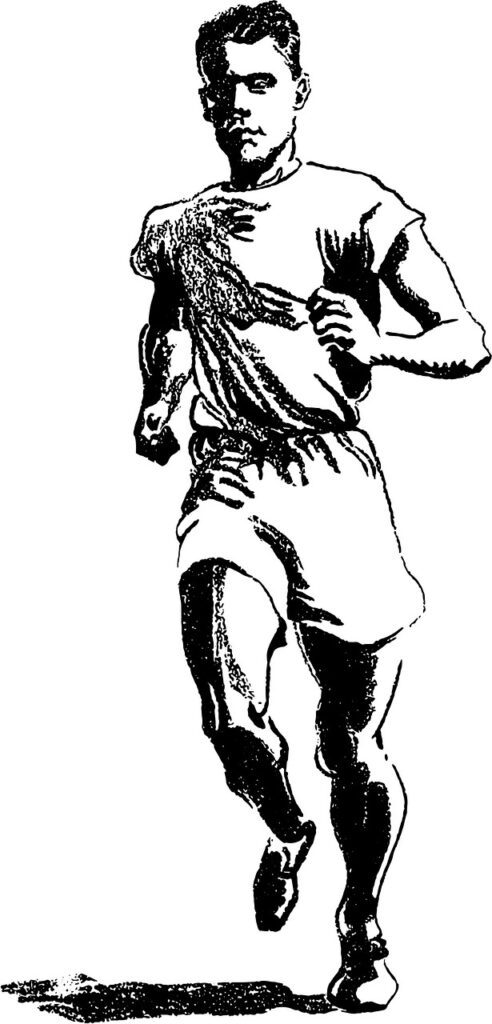I have previously written about what it looks like working with a Strength and Conditioning Coach to improve running performance. The specifics depend on whether you are training for sprints or middle distance running. In this article, I address Strength Training for Runners from the perspective of training for middle distance running.

When training sprinters, the difference between the acceleration phase and the maximum speed phase is important. As a result of these technical differences, there are different strength qualities that need to be trained for the respective phases of the sprint. However, middle distance running does not involve a distinct acceleration phase. This simplifies things for us somewhat, as we are now just looking at one technical model rather than two separate technical models.
Middle distance running is still performed at high speeds. World class 800m races can involve the first 400m being covered in sub 50 seconds. As such, with middle distance running we are simply looking at a slightly modified technical model from that of the maximum speed phase of a sprint race.
At this point we are well served to remind ourselves of some of the key technical points from the maximum speed phase of sprint running:
Upright Running Posture
Very Short Ground Contact Times
Very Large Vertical Ground Reaction Forces
Small Horizontal Ground Reaction Forces
Incomplete Triple Extension of the Hip, Knee and Ankle Joints
Minimal movement about the knee and ankle joints in particular during ground contact
Strength Training for Runners
In middle distance running, we still want an upright running posture. Running speed remains fairly consistent throughout the race (although I appreciate tactical races will involve some varied pace). However, the slightly slower pace does mean that there is an increase in ground contact times. Although the ground contact times are still short, the increase is sufficient enough to mean that triple extension of the hip, knee and ankle joints occurs to a fuller extent.
Given this information, Olympic Lifts and / or their derivatives seem like a great choice for the middle distance runner. These serve the purpose of developing triple extension power, primarily through the production of vertical ground reaction forces.
Even though triple extension is now occurring to a fuller extent, there is still a need for stiffness through the knee and ankle joints during ground contact. Quarter squats are a good example of an exercise that develops knee stiffness. There are a wide variety of additional exercises and methods that can also develop knee and ankle stiffness. Amongst these are plyometric exercises.
I strongly recommend the use of plyometrics for sprinters. Plyometrics also play an important role in the strength and conditioning of middle distance runners. That said, we need to be more cautious with endurance runners. Middle and long distance runners are already accumulating a lot of impact through the high running mileage that is necessary for these events. It can be risky to pile on additional impact forces in the form of plyometrics. This is where planning and timing comes into play. We need to include plyometrics at some point, due to the benefits they offer. However, this needs to be done during periods of lower mileage training in order to ensure the accumulation of impact forces does not become too high.
Strength Training and Plyometrics for Runners
Here’s some instances where it is possible to add plyometrics into the programme with runners:
- Early during winter training, shortly after the end of season break. At this point mileage will be a little lower since athletes are gradually building back up following their time off training.
- Recovery weeks. Many athletes have planned recovery weeks with reduced mileage. Other athletes may take recovery weeks when they feel like they need them, rather than planning them in. Either way, these weeks are a good opportunity to add in plyometric work. Quality plyometric work should be low in volume, so it should not interfere with the athletes ability to recover during these weeks.
- Tapering weeks. Similar to recovery weeks. Athletes are likely to back off the mileage and overall training during weeks leading up to a race. Again, this is another opportunity to incorporate a small amount of plyometric work, whilst the overall training load is lower.
- During event specific training periods leading up to the most important part of the race season. During this period of time, the high mileage work has been completed. There is now a focus on race pace sessions to provide the most specific training stimulus possible. High mileage in between these key sessions may interfere with recovery. Therefore, at this stage in the training cycle, mileage tends to be reduced. This is a great time to replace some of the impact from mileage accumulation with plyometric impact. Another reason why this is a great time to add in some plyometric work is because it will help to fully activate the nervous system, and thus assist in priming athletes for races.
Timing of Strength Training for Runners
As you can see, there are pockets of opportunity for middle distance runners to incorporate plyometric work into their programmes. The reason why these pockets of opportunity appear is usually because of a focus on recovery during these times. As such, a reduced volume (or possibly even complete removal) of the more traditional weight room based strength training is also needed during these pockets of opportunity in order to be congruent with that focus on recovery.
For middle distance runners, I find it works well to alternate between two different types of strength and conditioning work:
- Traditional weight room based activities (Block One – this will form the majority of Strength Training for Runners).
- Plyometric Training (Block Two – this is less frequent and these blocks of work are also generally for shorter periods of time).
Running First, Strength Second
We also need to consider how the Strength training for runners is placed.
The mantra ‘running first, strength second’ is one to live by. In essence, we need to make sure we are not carrying fatigue from the strength training sessions into our key running sessions. This would result in the fatigue accumulated from the strength work compromising the quality of the key running sessions. So, we need to structure and position these respective sessions with this thought process in mind. Depending on an athletes schedule, I recommend scheduling strength work in one of two ways:
- Key Running Session done in the morning, and then later on the same day, strength training performed in the afternoon
- Key Running Session done on, say, a Monday. Strength training then performed the following day, in this instance on a Tuesday.
Individualising Running Programmes
Bear in mind, the above will not always need to apply. Generally, I would recommend one to two Strength and Conditioning sessions per week for middle distance runners and two to three key running sessions (and of course additional easy and steady runs as well). So there will often be key running sessions which are not followed up by strength training work.
Also bear in mind, this is not a comprehensive list of Strength and Conditioning activity for middle distance runners. We have not given any mention to core strength work. This will also want to be included to some extent, in order to prevent unwanted, excessive rotational movement during the running stride and to prevent ‘energy leaks’. We have also given little consideration to how we would individualise the programme for specific athletes. Individual factors such as training experience, injury history, and time available for training can all have a significant influence on what the actual training programme looks like.
Another consideration is non-formal strength training. Running technique drills provide a low level strength training stimulus. Hill sprints provide a strength and power stimulus. You are likely to include these types of training in your programme. Including these training methods will impact your strength and conditioning. Higher amounts of hill sprint work will mean reduced focus on formal strength training. The same is true with running drills.
So it is clear. Strength training for runners needs to constantly change. The key is to plan your running training first. You can then plan your strength training around your running.
Strength and Conditioning for Runners in York
If you need help in making your strength training work for you. Or if you want to discuss the points made in this article in more detail, then please do get in touch. I am available for private strength and conditioning coaching for runners in York. For runners outside of York, I am available for online running coaching. Here are the links for both of these services:
Strength and Conditioning for Runners in York
You can also connect with me on Instagram if you have any questions on the above. Here is the link to my Instagram:
Foxwood Personal Training on Instagram
Good luck implementing the advice in this article. And for those looking for help in this area, I look forward to hearing from you!
Tim Egerton
The EGG
Egerton’s Garage Gym
Foxwood Personal Training, York
